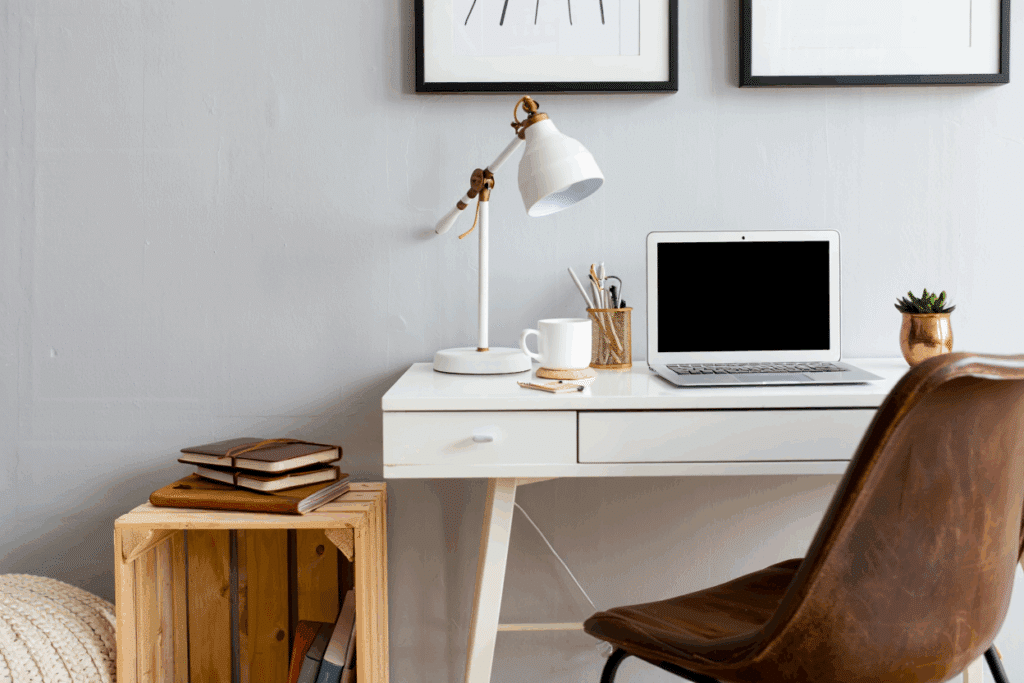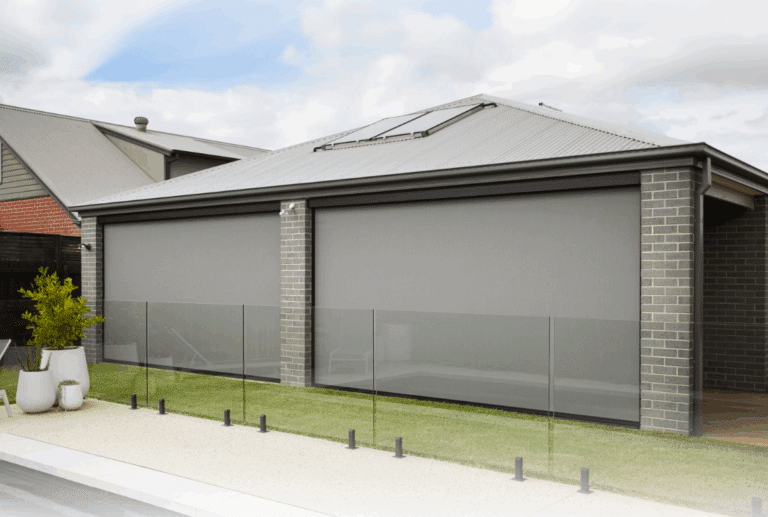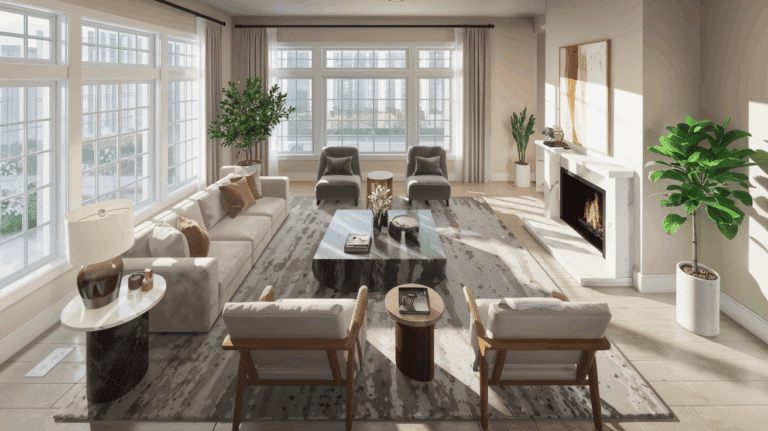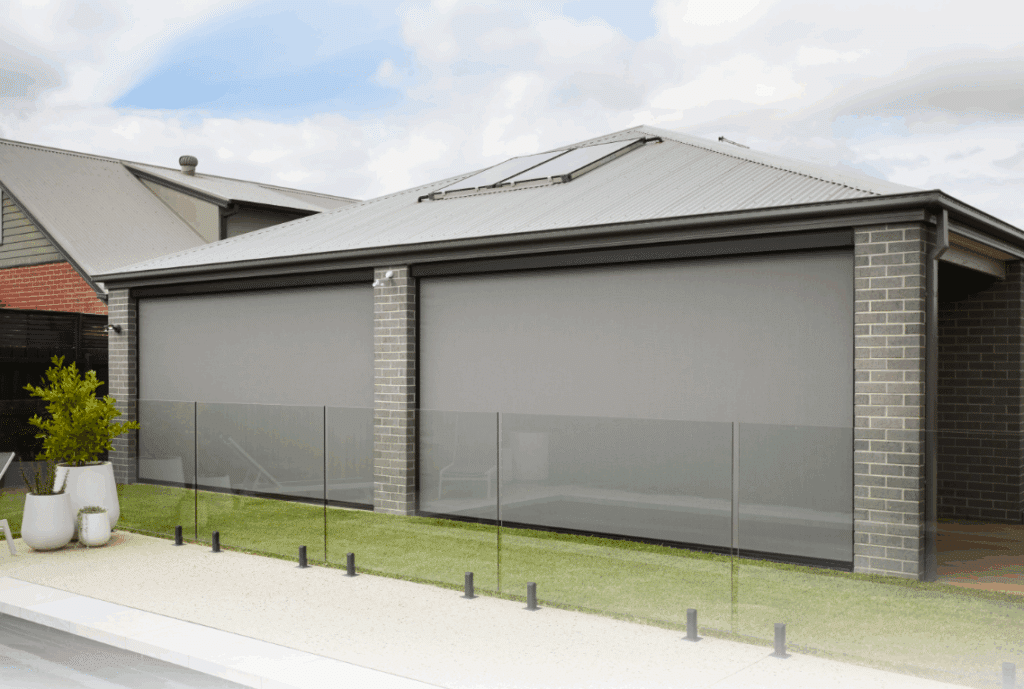Most people struggle with their workspace. It’s a common problem. Store-bought desks often miss the mark – they’re too large, too small, or simply don’t fit the budget.
This collection features DIY desk projects that work for various spaces and skill levels.
From quick afternoon builds to weekend projects, each design creates a functional, organized area tailored to individual needs.
Why settle for a standard desk when a custom solution costs less and fits better? These ideas change how people work from home or the office.
The Benefits of Building Your Own Desk
Making your own desk has more perks than you might think. It’s not just about saving money, though that’s a nice bonus!
Perfect Fit for Your Space
When you build a desk yourself, you can measure your exact space first. Got an awkward corner or a tiny nook? No problem.
Matches Your Exact Needs
We all work differently. Some people need lots of drawers while others want a wide, open surface. Maybe you need a special spot for your printer or a built-in charging station.
Cost Savings
A good quality desk can cost hundreds or even thousands of dollars. Building one yourself typically costs much less, especially if you use reclaimed materials or repurpose items you already have.
Your money goes toward exactly what matters to you.
Personal Satisfaction
There’s something special about sitting down at a desk you made with your own hands. Each day when you use it, you’ll feel a sense of pride. This personal connection makes your workspace more meaningful.
Learn New Skills
Building a desk teaches you useful skills like measuring, cutting, sanding, and finishing wood. These skills transfer to other projects around your home.
Express Your Style
Ready-made desks come in limited styles and finishes. Your DIY desk can showcase your personal taste with unique colors, materials, and design elements.
Eco-Friendly Option
By using reclaimed wood, repurposed furniture parts, or locally sourced materials, your DIY desk can be much better for the environment than mass-produced options that ship from far away.
Types of DIY Desks: Which One Fits Your Style
Looking for a desk that matches your style and space? Building your own DIY desk is a fun way to get exactly what you want.
There are many types of DIY desks, each with its own look and purpose. Let’s explore some popular options so you can find the one that’s right for you.
Simple DIY Desks: Quick and Easy Builds for Beginners
Simple DIY desks are perfect for beginners, offering easy builds with minimal tools and materials. These desks provide a practical and affordable solution for creating a functional workspace at home.
1. Live Edge Wood Desk
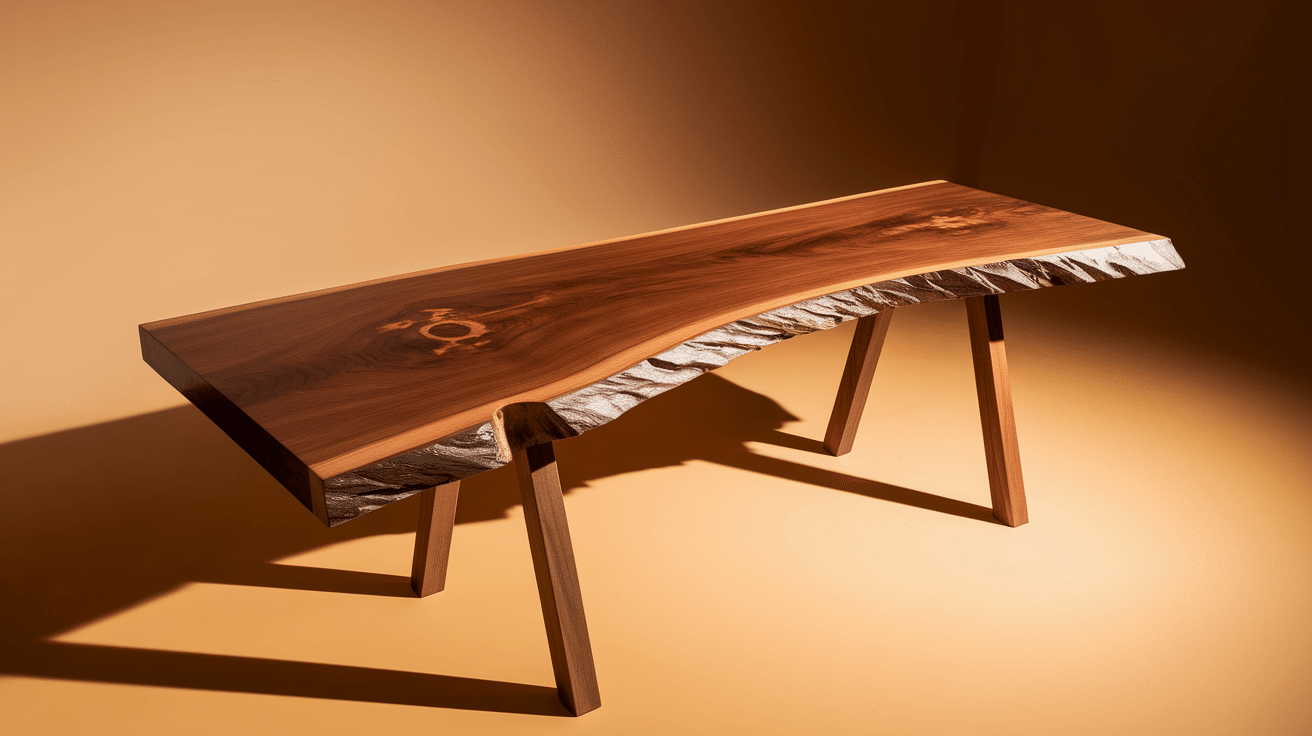
A live-edge wood desk is crafted from a single slab of solid wood, with the tree’s natural, uncut edge left exposed.
Common woods used include walnut, oak, ash, and beech, selected for their strength and unique grain. The surface is sealed to protect the wood and highlight its natural beauty.
Known for their rustic, artistic appeal, live-edge desks are durable, functional, and make a bold statement in both modern and traditional spaces.
For a More Detailed Guide: instructables.com
2. Fold-Away Desk

A fold-away desk is a wall-mounted desk that folds down for use and tucks flat against the wall when not needed, saving floor space.
Ideal for small spaces, apartments, or multipurpose rooms, it is typically made from lightweight plywood or MDF, with sturdy hinges and a locking system for stability.
Some designs also include built-in shelves for extra storage.
When folded up, the desk blends seamlessly into the wall, providing a practical and space-saving solution for flexible workspaces.
For a More Detailed Guide: localcolorxc.com
3. Simple Modern Wood Desk
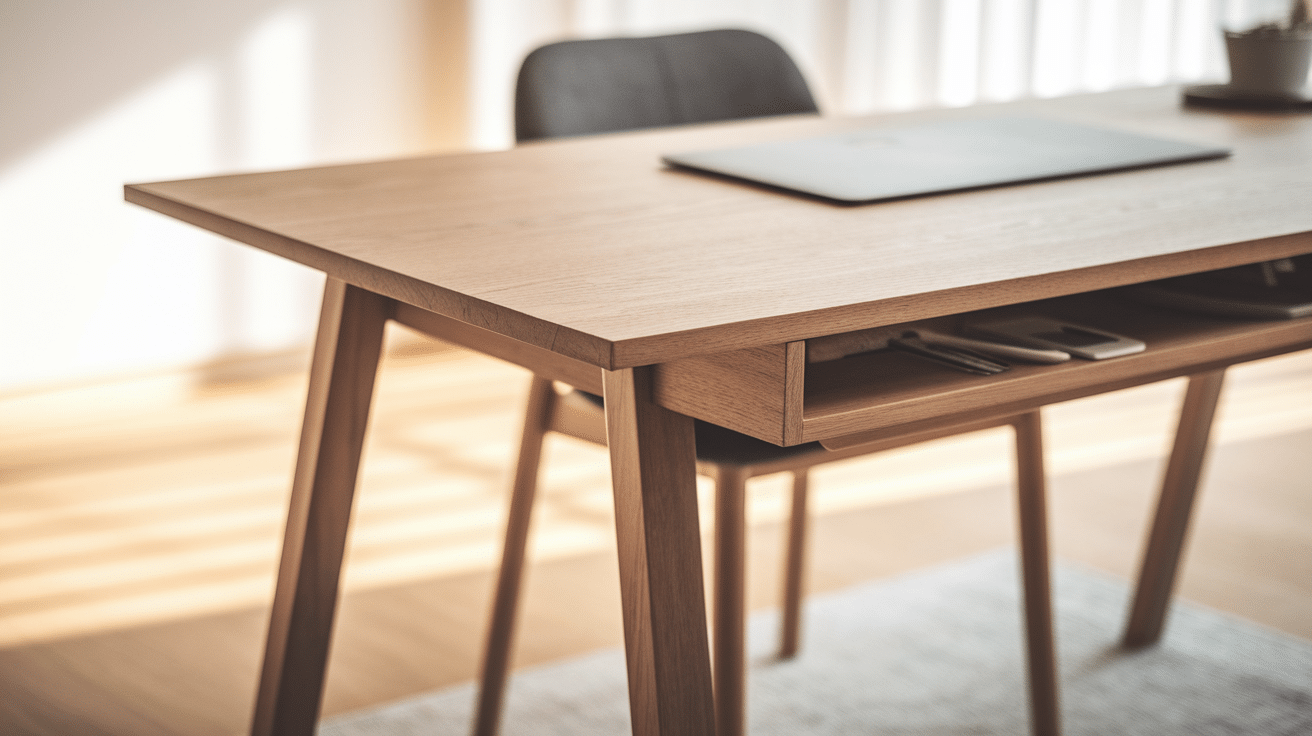
A simple modern wood desk offers a clean, minimalist design with straight lines and a smooth finish.
Made from solid wood like oak or walnut, or high-quality plywood, it typically features a rectangular top and four straight legs, sometimes with drawers or cable management.
The matte finish highlights the wood’s natural grain. Easy to assemble, these desks are ideal for home offices or living spaces seeking a clutter-free, contemporary look.
Durable and functional, they’re designed for everyday use.
For a More Detailed Guide: houseonlongwoodlane.com
4. Desk in a Closet
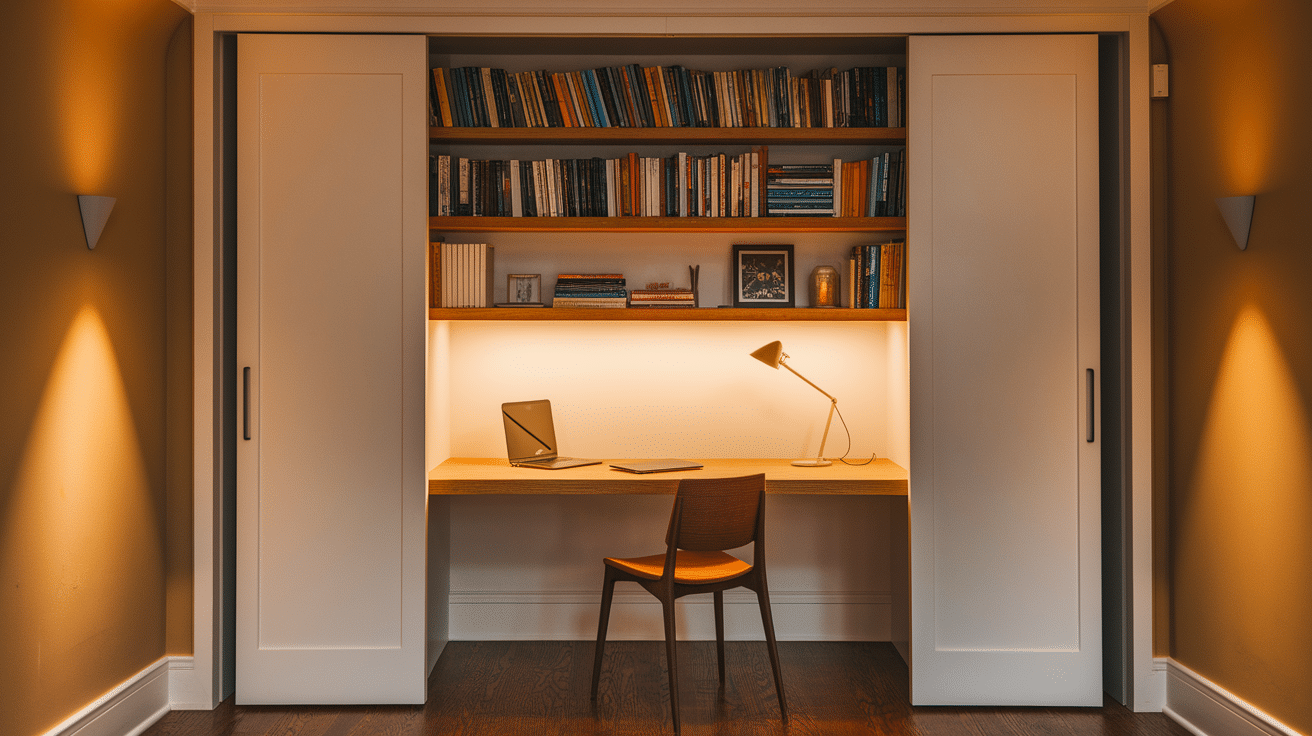
A “cloffice” is a desk set up in a closet, transforming an unused space into a compact, hidden workspace.
To create a closet, remove the closet doors (or use sliding doors), install a sturdy desktop at desk height, and add shelves for storage.
Power outlets, lighting, and organizers can also be included for added functionality.
When not in use, simply close the doors to keep the space tidy. This setup is perfect for small homes or those seeking a dedicated office space without using an entire room.
For a More Detailed Guide: perkinsonparkway.com
Budget-Friendly DIY Desks: Create Desks Under $50
Budget-friendly DIY desks allow you to create functional workspaces without breaking the bank.
Using inexpensive or recycled materials, these desks are perfect for those looking to save money while staying stylish and practical.
5. Cinder Block and Plank Desk
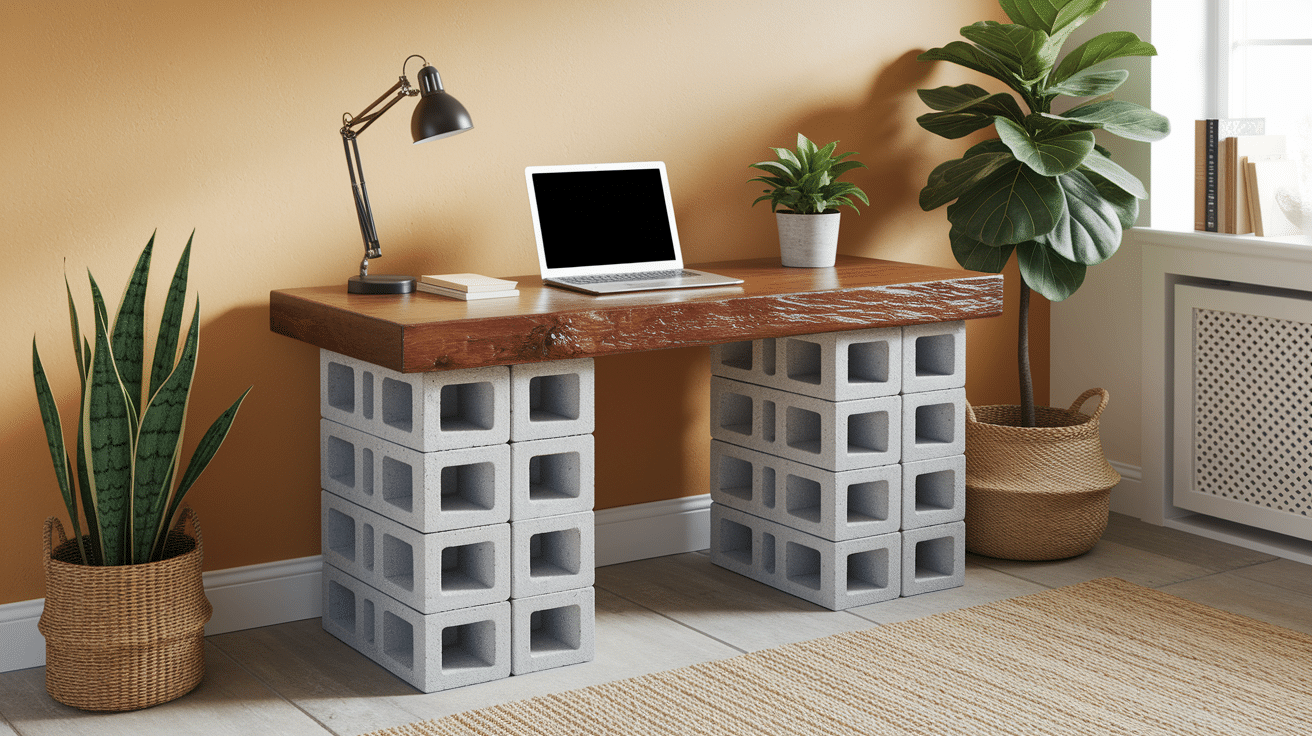
A cinder block and plank desk is a budget-friendly DIY option made from cinder blocks and a wooden plank.
To assemble, stack two or three cinder blocks on each side as legs, then place the plank across the top as the desktop.
No tools, screws, or glue are needed, making it ideal for renters or those seeking a temporary, movable workspace.
The hollow cinder blocks also provide extra storage for books or supplies. This desk is sturdy, functional, and perfect for students or home offices.
For a More Detailed Guide: apartmenttherapy.com
6. Hairpin Leg Desk
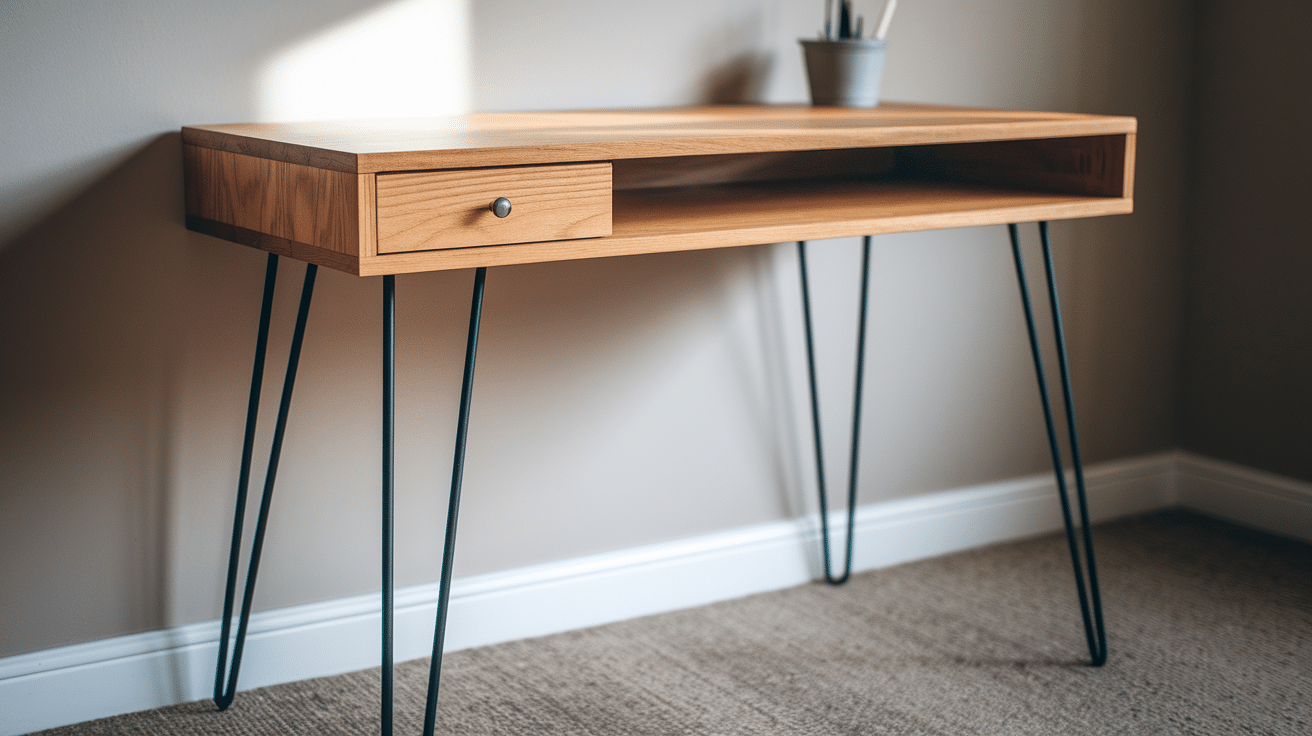
A hairpin leg desk features a sleek, modern design with easy DIY assembly.
It consists of a flat wooden top (made from solid wood, plywood, or even a reclaimed door) attached to four metal hairpin legs, known for their minimalist, mid-century style.
Assembly is simple—just screw the legs into the corners of the desk. The desk height can be customized with different leg lengths, and the surface can be finished with paint, stain, or sealant.
Lightweight yet sturdy, hairpin leg desks are perfect for small spaces like home offices, bedrooms, or apartments.
For a More Detailed Guide: abeautifulmess.com
7. Built-In Desk
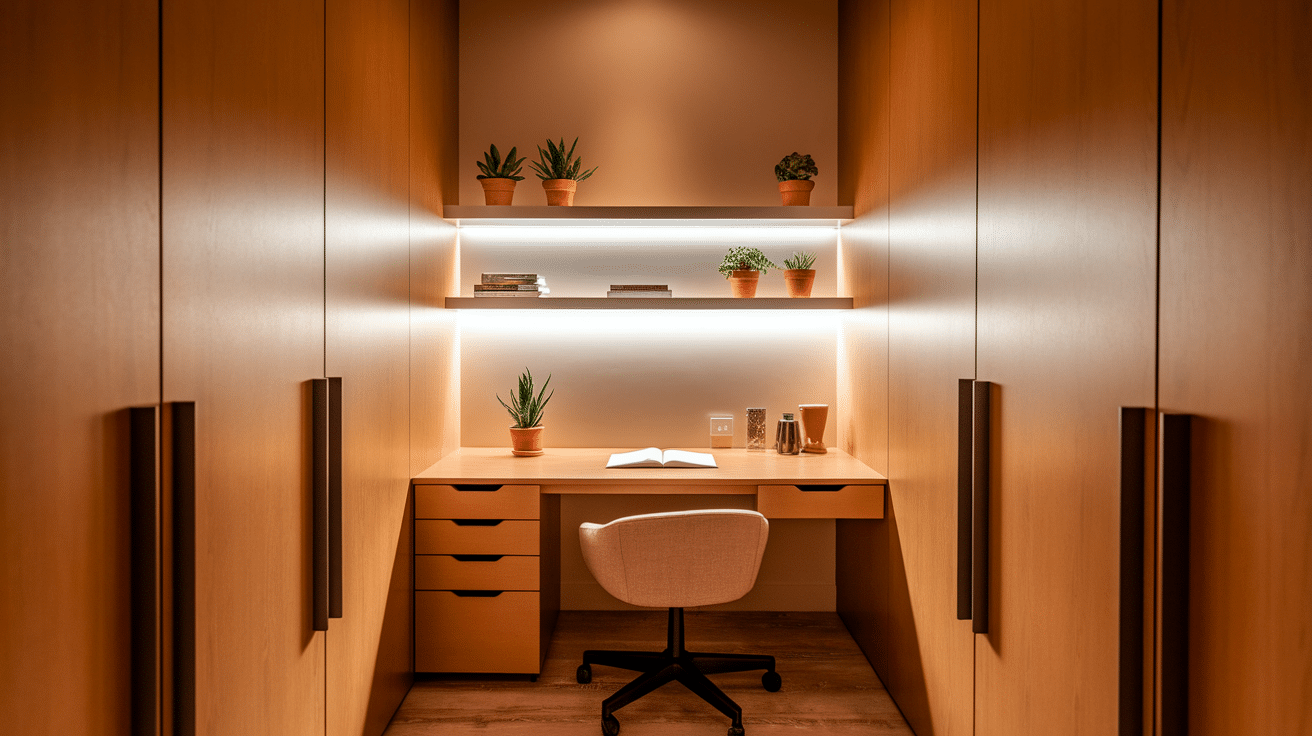
A built-in desk is a custom workspace designed to fit perfectly in a specific area, such as between walls, in a nook, or under a window.
Built-in desks maximize space and can be customized in width and depth, making them ideal for small rooms, home offices, or study corners.
Additional features like floating shelves, drawers, or cabinets can be added for extra storage. These desks are sturdy, space-efficient, and provide a polished, custom touch to any room.
For a More Detailed Guide: thekitchn.com
Modern DIY Desks: Contemporary Designs for Home Offices
Modern DIY desks offer sleek, contemporary designs that elevate home office spaces. These desks combine style and functionality, making them ideal for creating a professional, minimalist workspace.
8. Standing Desk with Curved Top
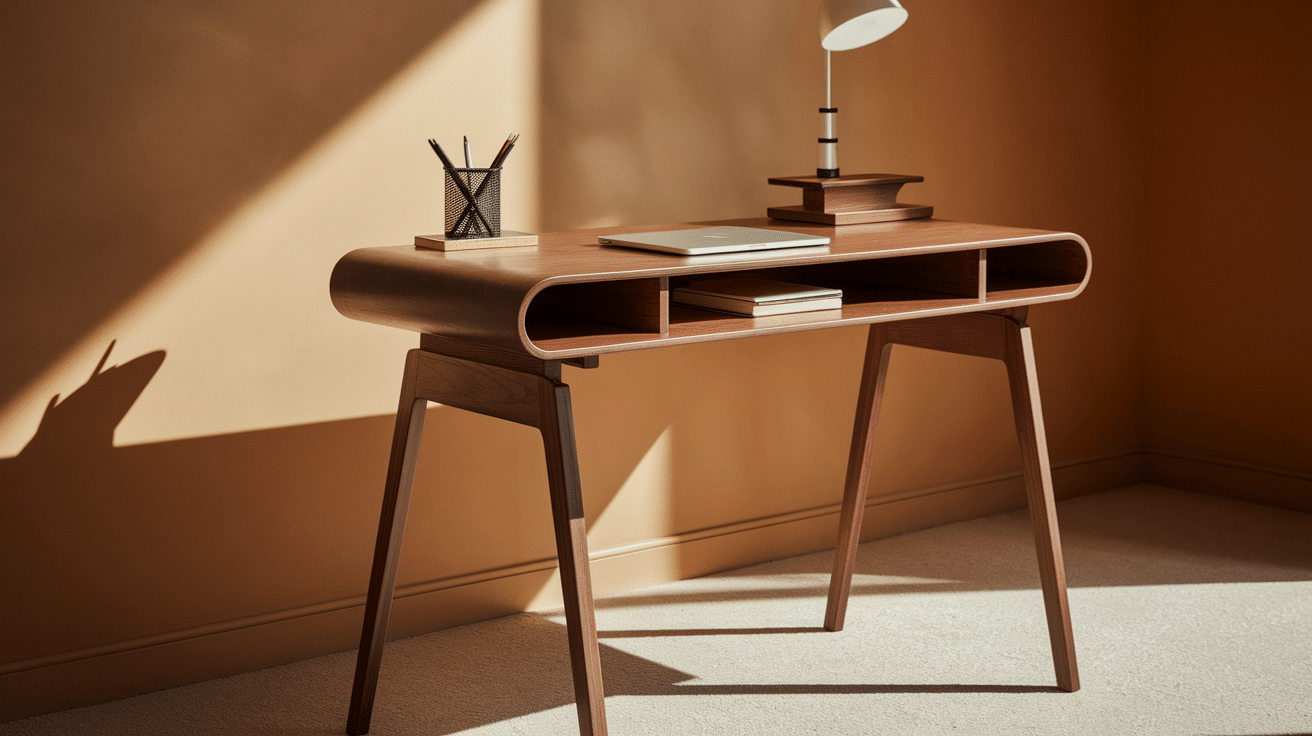
A standing desk with a curved top allows easy switching between sitting and standing, reducing strain on arms and shoulders.
Made from high-quality wood or engineered materials, it features adjustable height (manual or electric).
The curved design maximizes workspace and enhances aesthetics. Sturdy construction with reinforced legs ensures stability, while cable management and memory presets are often included.
Perfect for improving posture, reducing fatigue, and boosting productivity in home offices or workspaces.
For a More Detailed Guide: instructables.com
9. Steel Pipe Industrial Desk
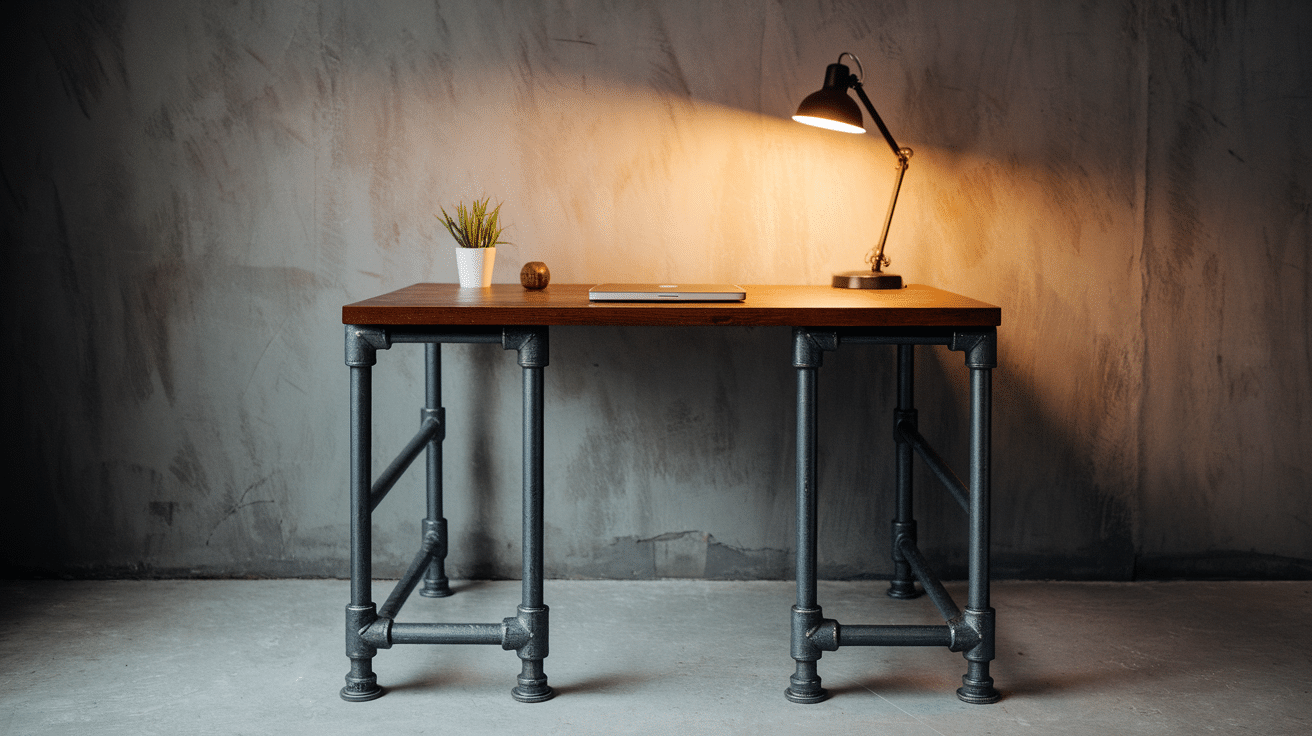
A steel pipe industrial desk features a rugged metal pipe frame with a solid wood or composite top. The pipes are assembled using threaded fittings, ensuring sturdiness and an industrial aesthetic.
The desktop can be customized in size and finish, ranging from reclaimed wood for a rustic look to sleek, stained wood for a modern touch.
This desk is durable, supports heavy equipment, and suits lofts, studios, or spaces with an industrial design.
The open frame provides extra legroom or storage beneath. Assembly is simple, requiring basic tools to connect the pipes and secure the top.
For a More Detailed Guide: thespaltydog.com
10. Floating Corner Desk
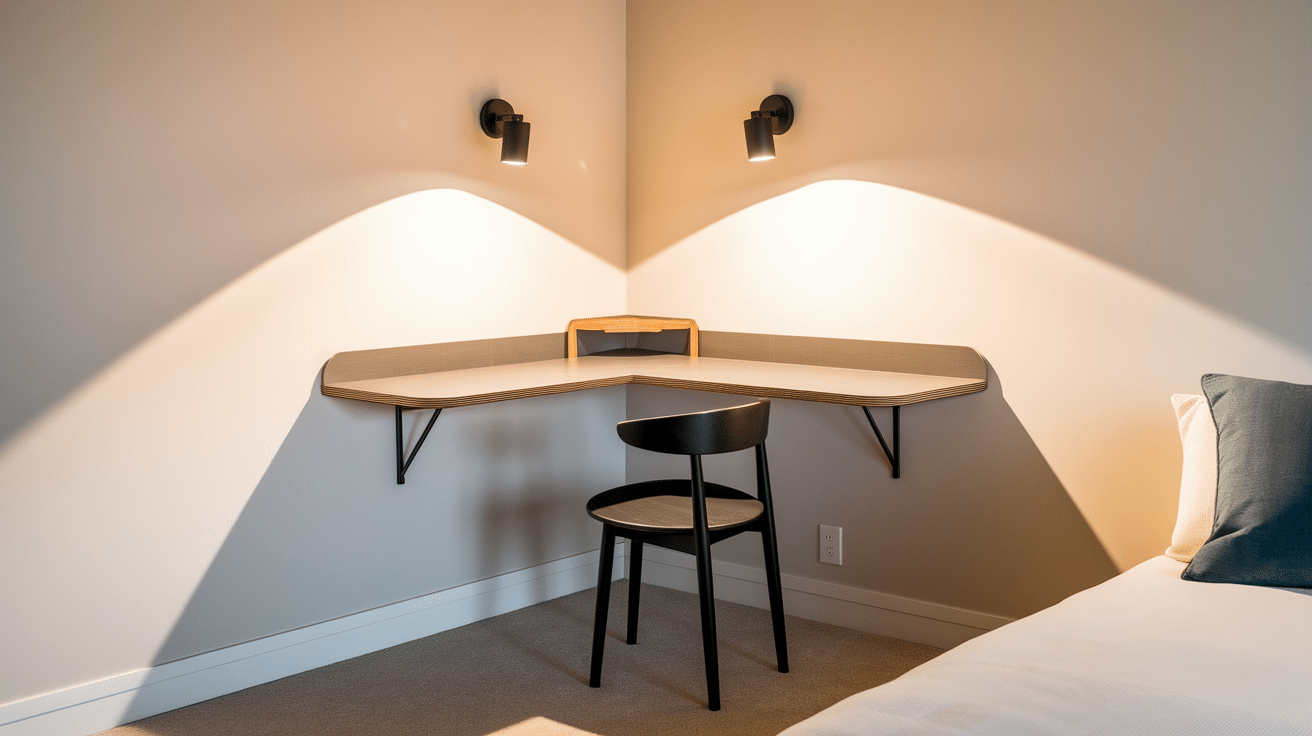
A floating corner desk is mounted directly to the walls in a room’s corner, eliminating the need for legs.
This design maximizes floor space, making it ideal for small rooms, bedrooms, or home offices.
The desk is typically made from plywood or MDF, cut to fit the corner, and supported by heavy-duty wall brackets or cleats. It can be customized with shelves for additional storage.
The minimalist design keeps the space open and organized. Proper installation requires careful measurement and secure mounting to wall studs for safety and stability.
For a More Detailed Guide: apartmenttherapy.com
11. Bookcase Standing Desk
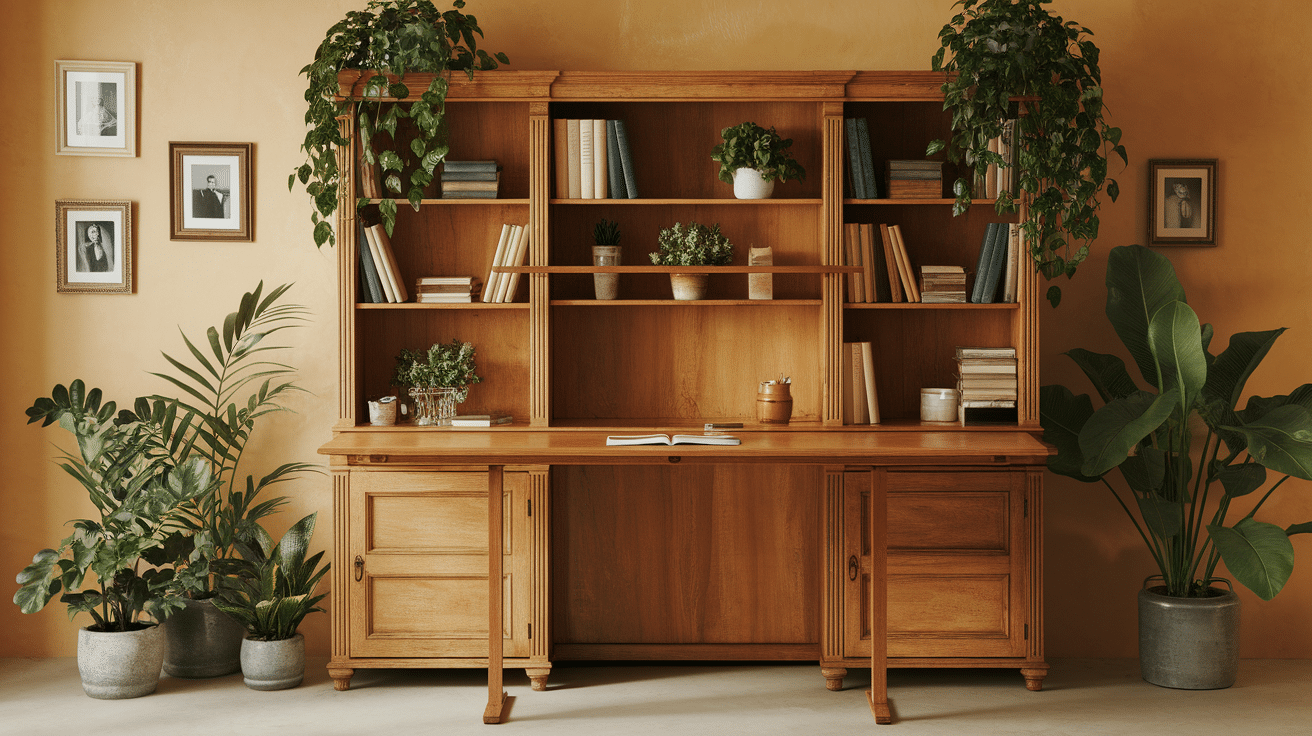
A bookcase standing desk combines a tall shelving unit with a built-in standing-height desk. To create one, a shelf is adjusted or removed at the desired desk height, and the structure is reinforced for stability.
The remaining shelves provide storage for books, supplies, and decor. This setup is perfect for small spaces, offering both workspace and vertical storage with minimal floor usage.
The design is adaptable to various room sizes and styles, with proper assembly ensuring stability, especially for heavier items on the shelves.
For a More Detailed Guide: offbeathome.com
Building your own desk is a fun project and helps you create a workspace that fits your needs!
Materials and Tools You’ll Need for Your DIY Desk
| Materials | Tools |
|---|---|
| 4 – 2×2 furring strip boards (8 FT each) | Tape Measure |
| 16 – 1 1/4” Kreg screws | Pencil |
| 6 – 1×3 select pine boards (8 FT each) | Safety Glasses |
| 1 – 1×3 select pine board (6 FT) | Ear Protection |
| 1 – 4×8 sheet birch plywood | Mask |
| 120 and 220 grit sandpaper | Miter Saw |
| Wiping Cloths (for stain/cleaning) | Circular Saw |
| Staining Pad | Sander |
| Varathane 8oz Stain in Flagstone | Kreg Jig |
| Wood Glue | Power Drill |
| Brad Nailer | |
| Table Saw |
Step-by-Step Instructions: Craft Your Perfect Desk
Building a desk can be an exciting and rewarding project! This DIY modern wood desk is perfect for your home office or study space and is an affordable way to create a stylish and functional piece of furniture.
Step 1: Make Your Cuts and Prep
Cut the wood pieces according to the printable plans using a circular saw for straight cuts and a miter saw for angled cuts. Ensure accurate measurements.
If you’re unsure about cutting, many home improvement stores, like Home Depot, offer cutting services, with the first five cuts free.
Clap plywood to a scrap board to guide the circular saw. Double-check measurements and keep pieces organized.
Step 2: Assemble the Desk Legs
For the desk legs, you’ll use the same construction method as our DIY modern outdoor furniture – think of it like building the armrests of a chair or sofa!
The legs should be sturdy but may initially feel a bit wobbly. Don’t worry; you can reinforce them later for added stability.
Follow the design in the printable plans, and use wood glue, screws, and a brad nailer to hold the pieces together.
Step 3: Attach Legs to Tabletop
Now, it’s time to attach the legs to your tabletop. Place the plywood on a flat surface (preferably not a sawhorse) to ensure it stays level while you attach the legs.
Take the time to measure and mark the placement of each leg before securing them with wood glue and screws.
Be sure to use a level to make sure everything is perfectly aligned. This will give your desk a clean and sturdy finish.
Step 4: Stabilize the Desk Frame
Once the legs are attached, it’s essential to add stability to the desk frame. Without these reinforcements, your desk might start to bow under the weight or general use.
Use 2×2 stabilizing pieces on the underside of the desk. These pieces will help prevent sagging and give your desk a solid foundation.
Secure them with wood screws, ensuring they’re evenly placed along the length of the desk.
Step 5: Add Cross Supports for Extra Stability
To address any remaining wobbiness or instability, add cross supports underneath the desk.
This additional step ensures your desk will hold up over time, especially with the constant weight of a computer or office supplies.
Position the cross supports evenly across the width of the frame and secure them with screws. This extra reinforcement will make a noticeable difference in how sturdy the desk feels.
Step 6: Iron On Plywood Edge Banding
Your desk is almost complete! To give the plywood edges a clean, finished look, apply edge banding.
Cut the banding to fit along the edges and use an iron to bond it to the wood. This step will cover up the rough edges and add a polished finish to your project.
If you’d like, you can also modify the design to add 1×2 pine boards around the edge for a thicker trim.
Step 7: Sand and Stain Your Desk
Before you assemble everything, it’s important to sand your desk thoroughly to remove any rough patches or imperfections. Use 120-grit sandpaper for the initial sanding, then finish with 220-grit for a smooth surface.
After sanding, you can stain your desk to give it a beautiful, rich finish. I recommend using a staining pad and wiping cloths to apply the stain evenly.
Apply the stain in thin coats, letting each layer dry before adding more. Don’t forget to wear your safety mask and gloves, especially if you’re pregnant, like I was when making this desk!
Desk Organization Tips: Keep Your Workspace Clutter-Free and Efficient
Here are some desk organization tips to keep your workspace clutter-free and efficient:
- Use Drawer Organizers: Keep small items like pens, paperclips, and sticky notes in drawer organizers to reduce desk clutter. Organize by category to easily access what you need without searching.
- Declutter Regularly: Take a few minutes at the end of each day to tidy up. Throw away unnecessary papers, recycle old documents, and return items to their designated spots.
- Utilize Vertical Space: Make use of shelves or wall-mounted organizers for books, binders, and office supplies. This keeps your desk surface clear while maximizing storage.
- Cable Management: Use cable organizers, clips, or a cable tray to keep cords and cables under control. This prevents them from tangling and helps maintain a clean and organized workspace.
- Keep Only Essentials on the Desk: Limit what you keep on your desk to only the essentials—your computer, notepad, a pen, and a few other items you use daily. Store everything else out of sight.
- File and Label Papers: Use a filing system to keep documents organized and out of the way. Label files clearly so you can easily find what you need without piles of paper cluttering your desk.
- Personalize, but Don’t Overcrowd: Add a few personal touches like a plant or framed photo to make your space feel inviting, but avoid over-decorating, which can contribute to clutter.
- Use Multi-Function Furniture: Invest in multi-purpose furniture, such as a bookcase with a built-in desk, or a desk with storage compartments, to keep everything organized in one place.
By implementing these desk organization tips, you’ll create a workspace that’s not only clutter-free but also more productive and enjoyable to work in.
The Bottom Line
Creating your own desk doesn’t just save money, it gives you a workspace that perfectly fits your needs. These DIY desk ideas offer solutions for every space, style, and budget.
What matters most is that your desk works for you. Whether you choose a floating design to maximize floor space, repurposed old furniture, or built something completely from scratch, the key is functionality.
Ready to convert your workspace? Pick a design that speaks to you and get started this weekend.
What desk design are you most excited to try? Share your project plans in the comments below!


